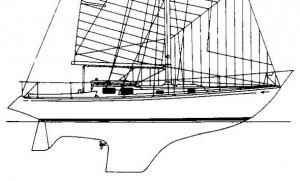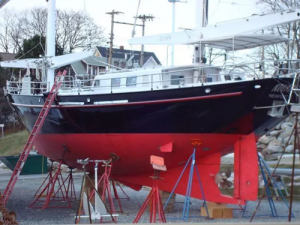Monohull, Sparkman & Stephens
33' x 6 Tons, Fin Keel
Seasquid
Force 9+ Conditions
File D/M-19, obtained from Ben Tucker, Australia - Vessel name Gypsy2, hailing port Hobart, monohull sloop designed by Sparkman & Stephens and built by Swarbrick, LOA 33' x LWL 25' x Beam 10' x Draft 5' 10" x 6 Tons - Fin keel - Drogue: Seasquid on 150' (45m) x 7/16" (11mm) kermantle dynamic nylon double braid rode plus 6ft (2m) of 8mm chain - Deployed in deep water midway on passage from Hobart, Australia to Bluff, New Zealand in winds of 45 knots gusting to 60kt and breaking seas of 20 - 30 ft. (6 - 10m) - Surfing down waves was inhibited, and speed was reduced to about 4 knots during 18 hours of deployment
Ben Tucker has over 70,000 miles of sailing experience, plus a million miles as an officer on a container ship. On this occasion he was sailing from Australia to New Zealand in early summer when he get caught in a strong gale:
On passage from Hobart to Bluff in early summer we got caught in a nasty low with strong westerly winds. Over the day the wind and seas built and quite suddenly it went from fun fast downwind sailing to dangerous just on dusk. We dropped the deep reefed main, and eventually ran with just a scrap of the roller reefing headsail set. As the seas built up we started surfing too fast for comfort down the front of the seas and deployed a sea squid on about 45 meters of 11mm kernmantle dynamic nylon rope that had previously been used for climbing. About 2 meters of 8 mm chain was shackled between the drogue and the warp. The drogue immediately slowed us down and controlled the surfing. But a big problem with our setup was soon revealed, the stretch in the drogue warp, coupled with the short line and only a short length of lightweight chain caused the drogue to break free of the approaching wave and fly forward towards us through the air about 10 meters and then re-engage, this would allow the boat to accelerate quickly to 7 or 8 knots until the drogue reengaged and with a brutal jerk it then slowed us down again to around 4 knots, this would often rip the drogue back out of the water again, repeating the cycle. It was clear that the wavelength was around 100 meters or so, as the drogue was visible behind us on the approaching crest when we were near the trough. It was deployed off the port quarter with no bridle to keep it clear of the windvane. We added a length of 19mm polypropylene line approximately 100 meters long in parallel with the drogue. This slowed us down enough that the drogue remained in the water with a more steady pull. We rode out the night hand steering with a small scrap of jib sheeted tight amidships and the drogue and warp behind. Many times the cockpit filled with water, and were buffeted badly by the bigger crests, bouncing down the wave face. But by early morning it had eased significantly. We found that the windvane had been damaged by the drogue line at some point, and the plastic sea squid drogue had a bad crack in it, probably due to the tumbling as it flew through the air, then tangled with the chain and reengaged. the biggest lesson was to avoid using a dynamic rope with a drogue, Have at least 100 meters of warp available and plenty of heavy chain on the end to keep it well under water. The next time I used a drogue sailing to Antarctica on my 33 foot yacht Snow Petrel I had no issues with a much longer line, approximately 120 meters of 18mm polypropylene and 10 meters of 10mm chain using a Seabrake HSD 300 and the pull was very steady and consistent.
Once again we have problems with drogues skipping out of the waves, in this case exacerbated by using a very stretchy climbing rope as a rode. Elasticity is crucial in the rode for a para-anchor so as to prevent shock loading, but in a drogue a non-stretchy rode, combined with some weight at the drogue end, helps to keep the rode submerged leading to a more constant rode tension.
Ben notes that the wave length was about 100m and the drogue rode about half that. One would expect that this might work well, placing the drogue on the back of the when one needs it most, ie surfing down the face of the same wave, but in this case the extreme stretching of the rode seems to have counteracted this, resulting in the drogue pulling out of the water with the concomitant rapid acceleration of the boat.
As the Furgusons on St. Leger (D/M 17) found, one needs to either have a long rode with more weight to cover a wider range of conditions (as did Ben Tucker on his next adventure), or else be able to adjust it from the cockpit to specifically tune it to the conditions at the time.




